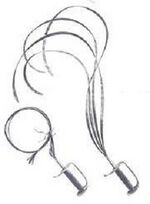Engineering:Urumi
| Urumi | |
|---|---|
 A pair of multi-bladed Sri Lankan ethunu kaduwa wielded by an Angampora practitioner | |
| Type | Sword |
| Place of origin | Indian subcontinent |
| Specifications | |
| Length | approx. 122–168 cm (48–66 in) |
An urumi (Malayalam: uṟumi; Sinhalese: ethunu kaduwa; Hindi: āra) is a sword with a flexible, whip-like blade, originating in modern-day Kerala in the Indian subcontinent.[1] It is thought to have existed from as early as the Sangam period.
It is treated as a steel whip[2] and therefore requires prior knowledge of that weapon as well as the sword. For this reason, the urumi is always taught last in Indian martial arts such as Kalaripayattu.
The word urumi is used to refer to the weapon in Malayalam. In Kerala, it is also called chuttuval, from the Malayalam words for "coiling," or "spinning," (chuttu) and "sword" (val).[2] Alternatively, Tamil names for the weapon are surul katti (coiling knife), surul val (coiling sword) and surul pattakatti (coiling machete).
Structure
The urumi hilt is constructed from iron or brass and is identical to that of the talwar, complete with a crossguard and frequently a slender knucklebow. The typical handle is termed a "disc hilt" from the prominent disc-shaped flange surrounding the pommel. The pommel often has a short decorative spike-like protrusion projecting from its centre. The blade is fashioned from flexible edged steel measuring 0.75 to 1 in (19 to 25 mm) in width. Ideally, the length of the blade should be the same as the wielder's armspan, usually between 4 to 5.5 ft (1.2 to 1.7 m). Multiple blades are often attached to a single handle. The Sri Lankan variation can have up to 32 blades and is typically dual-wielded, with one in each hand.[3]
Use
The urumi is handled like a flail but requires less strength since the blade combined with centrifugal force is sufficient to inflict injury. As with other "soft" weapons, urumi wielders learn to follow and control the momentum of the blade with each swing, thus techniques include spins and agile manoeuvres.[2] These long-reaching spins make the weapon particularly well suited to fighting against multiple opponents. When not in use, the urumi is worn coiled around the waist like a belt, with the handle at the wearer's side like a conventional sword.[2]
Legacy
A peptide found in the mucus of a South Indian frog is named urumin. This name is inspired from the urumi, since urumin kills the H1N1 flu virus effectively.[4][5]
See also
- Angampora
- Chain whip
- Kalaripayattu
- Silambam
References
- ↑ Devnath, Vinay (2016-07-09). "10 Deadly Weapons That Originated In India" (in en-GB). https://www.storypick.com/deadly-indian-weapons/.
- ↑ 2.0 2.1 2.2 2.3 Saravanan, T. (January 14, 2005). "Valorous Sports Metro Plus Madurai". The Hindu. http://www.hindu.com/thehindu/mp/2005/01/14/stories/2005011400050100.htm.
- ↑ "හෙළයේ සටන් රහස අංගම්" (in si). Lankadeepa. September 7, 2013. http://www.lankadeepa.lk/index.php/articles/166910.
- ↑ Mole, Beth (April 19, 2017). "South Indian frog oozes molecule that inexplicably decimates flu viruses". https://arstechnica.com/science/2017/04/south-indian-frog-oozes-molecule-that-inexplicably-decimates-flu-viruses/.
- ↑ Holthausen, David J. et al. (April 18, 2017). "An Amphibian Host Defense Peptide Is Virucidal for Human H1 Hemagglutinin-Bearing Influenza Viruses". Immunity 46 (4): 587–595. doi:10.1016/j.immuni.2017.03.018. PMID 28423338. https://www.cell.com/immunity/pdf/S1074-7613(17)30128-0.pdf.
 |


